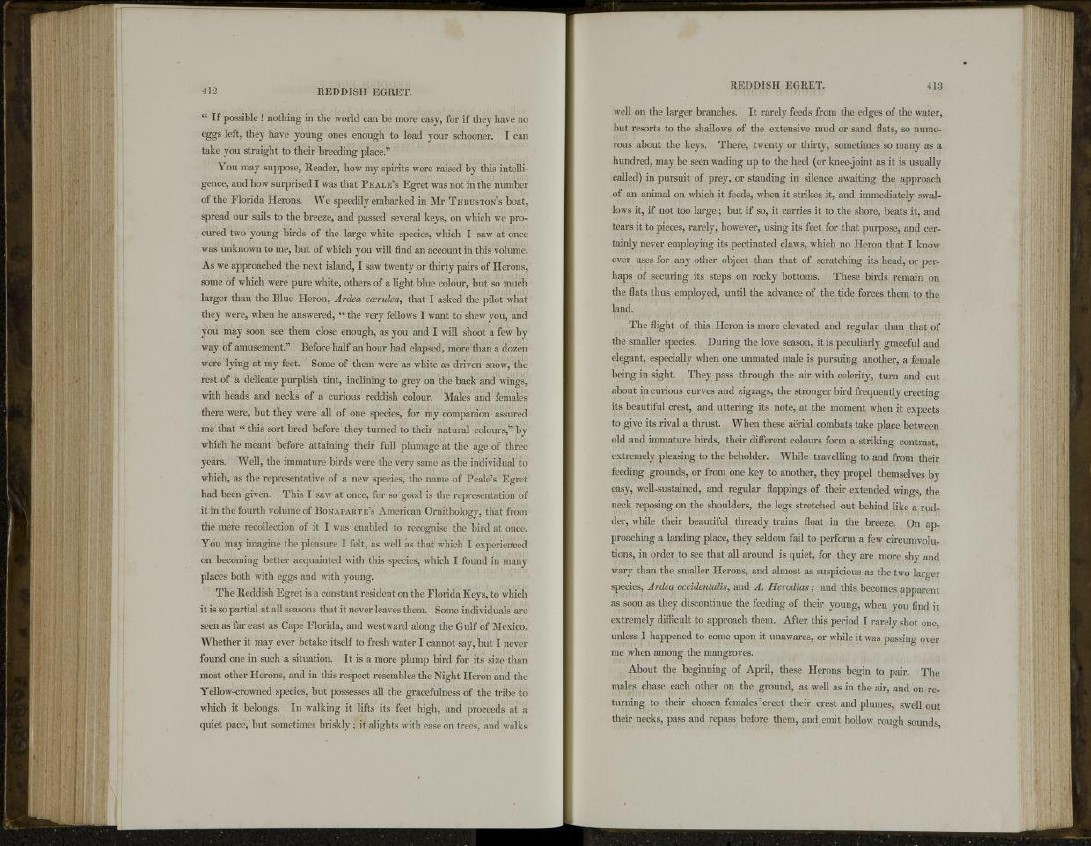
412 REDDISH EGRET.
" If possible ! nothing in the world can be more easy, for if they have no
eggs left, they have young ones enough to load your schooner. I can
take you straight to their breeding place."
You may suppose, Reader, how my spirits were raised by this intelligence,
and how surprised I was that PEALE'S Egret was not in the number
of the Florida Herons. We speedily embarked in Mr THRUSTON'S boat,
spread our sails to the breeze, and passed several keys, on which we procured
two young birds of the large white species, which I saw at once
was unknown to me, but of which you will find an account in this volume.
As we approached the next island, I saw twenty or thirty pairs of Herons,
some of which were pure white, others of a light blue colour, but so much
larger than the Blue Heron, Ardea cccrulca, that I asked the pilot what
they were, when he answered, " the very fellows I want to shew you, and
you may soon see them close enough, as you and I will shoot a few by
way of amusement.'11 Before half an hour had elapsed, more than a dozen
were lying at my feet. Some of them were as white as driven snow, the
rest of a delicate purplish tint, inclining to grey on the back and wings,
with heads and necks of a curious reddish colour. Males and females
there were, but they were all of one species, for my companion assured
me that " this sort bred before they turned to their natural colours,11 by
which he meant before attaining their full plumage at the age of three
years. Well, the immature birds were the very same as the individual to
which, as the representative of a new species, the name of Peale's Egret
had been given. This I saw at once, for so good is the representation of
it in the fourth volume of BONAPARTE'S American Ornithology, that from
the mere recollection of it I was enabled to recognise the bird at once.
You may imagine the pleasure I felt, as well as that which I experienced
on becoming better acquainted with this species, which I found in many
places both with eggs and with young.
The Reddish Egret is a constant resident on the Florida Keys, to which
it is so partial at all seasons that it never leaves them. Some individuals are
seen as far east as Cape Florida, and westward along the Gulf of Mexico,
Whether it may ever betake itself to fresh water I cannot say, but I never
found one in such a situation. It is a more plump bird for its size than
most other Herons, and in this respect resembles the Night Heron and the
Yellow-crowned species, but possesses all the gracefulness of the tribe to
which it belongs. In walking it lifts its feet high, and proceeds at a
quiet pace, but sometimes briskly ; it alights with ease on trees, and walks
REDDISH EGRET. 413
well on the larger branches. It rarely feeds from the edges of the water,
but resorts to the shallows of the extensive mud or sand flats, so numerous
about the keys. There, twenty or thirty, sometimes so many as a
hundred, may be seen wading up to the heel (or knee-joint as it is usually
called) in pursuit of prey, or standing in silence awaiting the approach
of an animal on which it feeds, when it strikes it, and immediately swallows
it, if not too large; but if so, it carries it to the shore, beats it, and
tears it to pieces, rarely, however, using its feet for that purpose, and certainly
never employing its pectinated claws, which no Heron that I know
ever uses for any other object than that of scratching its head, or perhaps
of securing its steps on rocky bottoms. These birds remain on
the flats thus employed, until the advance of the tide forces them to the
land.
The flight of this Heron is more elevated and regular than that of
the smaller species. During the love season, it is peculiarly graceful and
elegant, especially when one unmated male is pursuing another, a female
being in sight. They pass through the air with celerity, turn and cut
about in curious curves and zigzags, the stronger bird frequently erecting
its beautiful crest, and uttering its note, at the moment when it expects
to give its rival a thrust. When these aerial combats take place between
old and immature birds, their different colours form a striking contrast,
extremely pleasing to the beholder. While travelling to and from their
feeding grounds, or from one key to another, they propel themselves by
easy, well-sustained, and regular flappings of their extended wings, the
neck reposing on the shoulders, the legs stretched out behind like a rudder,
while their beautiful thready trains float in the breeze. On approaching
a landing place, they seldom fail to perform a few circumvolutions,
in order to see that all around is quiet, for they are more shy and
wary than the smaller Herons, and almost as suspicious as the two larger
species, Ardea occidentalism and A . Herodias; and this becomes apparent
as soon as they discontinue the feeding of their young, when you find it
extremely difficult to approach them. After this period I rarely shot one,
unless I happened to come upon it unawares, or while it was passing over
me when among the mangroves.
About the beginning of April, these Herons begin to pair. The
males chase each other on the ground, as well as in the air, and on returning
to their chosen females erect their crest and plumes, swell out
their necks, pass and repass before them, and emit hollow rough sounds,